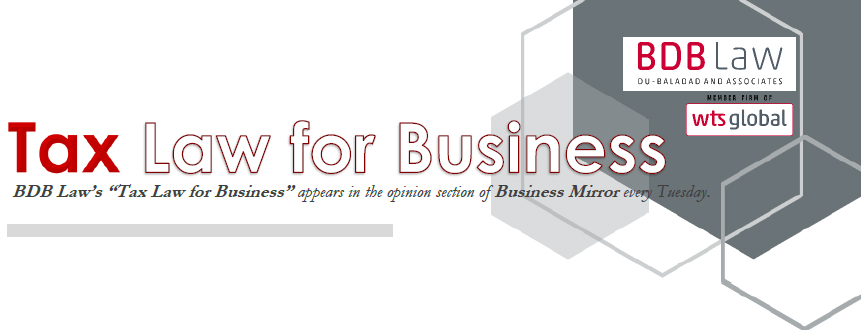
DIGITAL SERVICES TAX: AN ASEAN COMPARISON
By: Atty. Jomel N. Manaig
"How does our Digital Services Tax fare with those of our neighboring countries? What are the similarities? What are the differences?"
 Atty. Jomel N. Manaig +632 8403-2001 loc. 140 |
The Philippines has been playing catch-up with the rest of the world for the past few years when it comes to taxation. On the domestic landscape, the implementation of the transfer pricing regulations saw some movement when new rules and requirements were introduced to help the BIR identify related party transactions. On a more international scope, the Philippines joined the Inclusive Framework on Base Erosion and Profit Shifting which underscores the country’s commitment in addressing the tax challenges arising from the digitalization of the economy by participating in what is known as the Two-Pillar Solution.
Slowly, but surely, we are moving. And the latest step in the reformation of our tax system is the approval by the Senate of the imposition of VAT on digital transactions, or what is more commonly known as the “Digital Services Tax.”
 But how does our Digital Services Tax fare with those of our neighboring countries? What are the similarities? What are the differences?
But how does our Digital Services Tax fare with those of our neighboring countries? What are the similarities? What are the differences?
The proposed DST is basically the imposition of VAT on digital services (e.g. online services, digital goods, as well as commercial transactions entered into using online or e-marketplaces). In other words, it deals only with the imposition of a consumption tax (i.e. VAT). Limiting the tax on digital transactions to only consumption taxes appears to be the norm in most countries: Malaysia imposes a service tax; Singapore imposes a Goods and Services Tax (GST); while Thailand also imposes VAT.
However, some countries chose to impose a combination of consumption tax and income tax. For example, both Vietnam and Indonesia chose a model wherein VAT and personal/corporate income taxes will be imposed once certain thresholds (e.g. income, profit, number of local users, etc.) were breached. The inclusion of income taxes in the taxation of digital services was mainly due to the tax leaks arising from the shifting of profits derived from the jurisdiction of the market to the jurisdiction of the seller.
It should be noted that the Pillar One solution of the Organisation for Economic Co-operation and Development (OECD) was made to address this exact tax concern by reallocating certain amounts of taxable income to market jurisdictions. However, its implementation is still a hanging question, and its applicability is limited to large multinationals only. While Vietnam and Indonesia may think that this is the more equitable and favorable approach, perhaps the limitation of the imposition to cover only consumption tax is more in line with principles of double taxation and the various international/bilateral tax agreements entered into to prevent it from occurring.
The scope of what constitutes “digital services” in our DST is likewise fairly consistent with the scope for our neighbors. Essentially, digital services cover a wide gamut of e-commerce transactions: from online services to digital goods and even physical goods purchased/sold through digital intermediaries like online/e-markets.
Nonetheless, Malaysia seemed to have taken a more nuanced approach wherein the imposition of its digital service tax is limited to the sale of digital products (e.g. subscriptions to digital media and content) and digital services. It does not include the purchase of physical goods through electronic platforms and markets. The wider scope applied to our DST ensures that we get a wider tax base which translates to higher tax collection.
Another common feature among ASEAN countries (with the exception of Malaysia) is the adoption of the reverse charge mechanism wherein the local consumer shall withhold and remit the digital tax to the tax authorities. The tax liability is shifted away from the foreign supplier. This is a very efficient mechanism that simplifies the bureaucratic and tax reporting process as well as prevent tax fraud.
However, I believe that we should revisit or realign our DST to address certain concerns in the reverse charge mechanism.
The first concern is on the issuance of the related invoice. In certain jurisdictions, if the reverse charge mechanism is adopted, the invoice will reflect that no tax is imposed on the transaction since the liability is shifted to the consumer. Applying that in the local context, invoices issued by non-resident digital service providers (NDSP) may be net of VAT. This may be a concern since our proposed DST requires VAT-registered NDSPs to issue invoices in an amount inclusive of VAT.
The second concern is the requirement of registration by NDSPs. The reverse charge mechanism should be used in such a way as to do away with registration of NDSPs since taxes are withheld and remitted by the local customer. Applying the reverse charge mechanism and the mandatory registration of NDSPs creates overlapping tax requirements.
As you can see, our DST is more or less consistent with the trend in the ASEAN region. However, if we look farther away, the more we can see more crucial differences. From differentiating between business-to-business and business-to-consumer transactions, to changing tax bases, and even to the various entities that may be required to withhold/collect the tax, there is a lot to be discussed. Another time perhaps?
The author is a junior partner of Du-Baladad and Associates Law Offices (BDB Law), a member-firm of WTS Global.
The article is for general information only and is not intended, nor should be construed as a substitute for tax, legal or financial advice on any specific matter. Applicability of this article to any actual or particular tax or legal issue should be supported therefore by a professional study or advice. If you have any comments or questions concerning the article, you may e-mail the author at This email address is being protected from spambots. You need JavaScript enabled to view it. or call 8403-2001 local 140.




